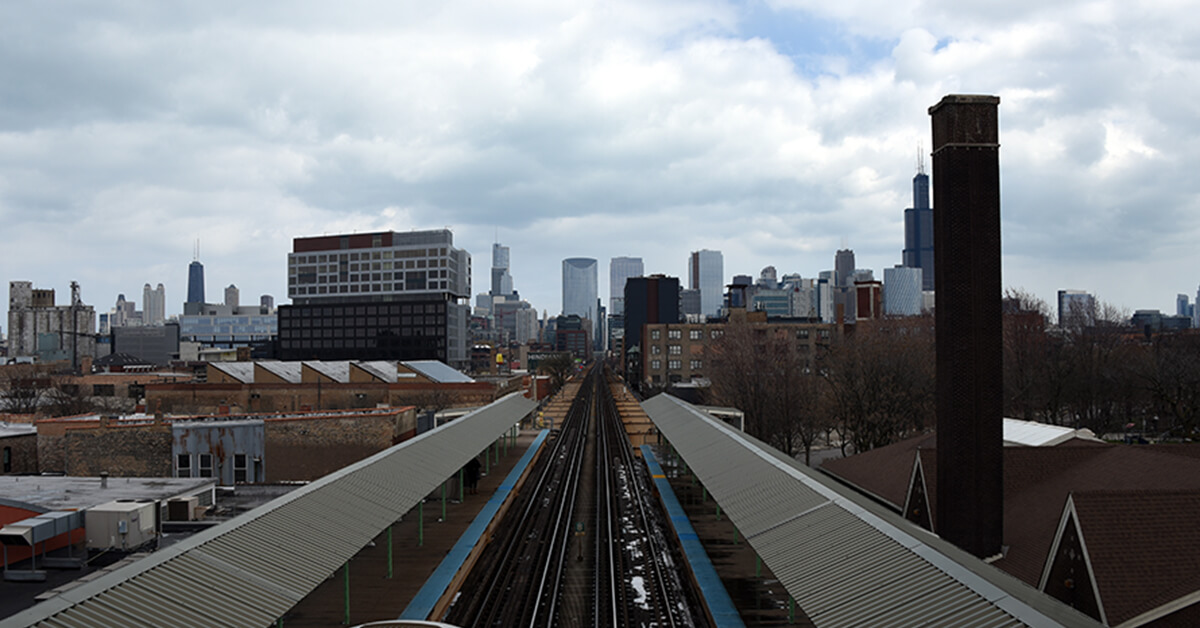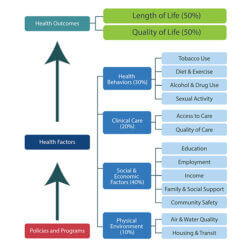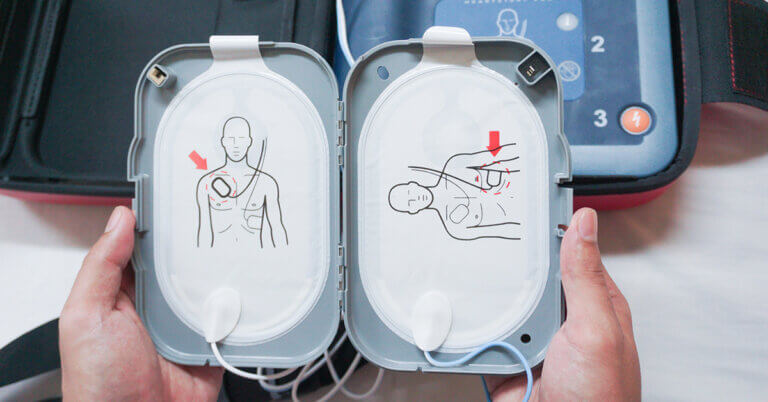December 20, 2022

Community Life Is Health: Health Multiplier Programming in Action
Oakley Square Apartments is a residential complex that borders the Garfield Park neighborhood on Chicago’s west side. In his 2017 book, Dr. David Ansell coined the term “death gap” to describe the sixteen-year difference in life expectancy between individuals living in Garfield Park and those living just six miles east in the downtown Chicago Loop. Garfield Park’s life expectancy is only 69 years. In the Loop, it’s 85 years.
As a physician practicing in Garfield Park, Ansell witnessed the conditions that trigger the neighborhood’s low life expectancy. Pervasive inequality was the causal factor underlying the dismal health status metrics. Compared to those living in the Loop, Garfield Park residents are two times more likely to die of cancer, four times more likely to die of diabetes, nine times more likely to die of diabetes, and 57 times more likely to die by assault.
Given these grim statistics, it’s not surprising that ten years ago Oakley Square Apartments was a dangerous place to live. The complex was in desperate need of repair and plagued by rampant drug and crime activity. Neighbors stayed away from the complex out of fear for their own safety. Who could blame them? No one living in Oakley Square thought of it as a place to call home.
Here’s what is surprising. Oakley Square is now a thriving residential community where neighbors flock to attend dance classes, take cooking lessons, exercise, practice yoga, tutor students and visit the on-site medical clinic. This dramatic change didn’t happen by accident. These improvements reflect Community Life and health multipliers in action.
So what are Community Life and health multipliers?
Human Infrastructure That Builds Community
In 2012, the U.S. Department of Housing and Urban Development (HUD) invited The Community Builders (TCB) to take over the management of Oakley Square. TCB is the nation’s largest nonprofit developer of affordable housing. What distinguishes TCB are the community-building investments the company makes in human as well as physical infrastructure. These human infrastructure investments are health multipliers. They reduce isolation, build resiliency, promote skill development and self-sufficiency. They advance well-being.
TCB has three divisions: Property Development, Property Management and Community Life (CL). Community Life’s professionals engage residents, amplify their voices and empower them with agency to solve their problems. With resident input, CL teams create enriching activities and partner with local organizations to build cohesive communities. Through Community Life, TCB manifests the “power of home” and lives its mission of “building and sustaining strong communities where all can thrive.”
This is not an unbiased commentary. I am on the TCB Board and a member of the Community Life Sub-Committee. I also chair TCB’s Chicago Advisory Committee. The physical and human improvements that TCB’s team members create in historically challenged neighborhoods are remarkable, even breathtaking. It is easy for me to loudly and proudly support TCB, CL and the invaluable work they undertake to empower residents and build sustainable communities.
Rose Mabwa leads the Chicago CL team. When it took control of Oakley Square, TCB’s development arm cleaned up the complex, made repairs and upgraded the residences. That was the easy part.
Rose and her CL team began their revitalization task by asking residents this simple question, “What would it take to make Oakley Square a place you would call home?” Their answers became the blueprint for building the social connections and programming that transformed apartment units into homes.
It’s truly remarkable what CL and residents can accomplish together when there’s shared purpose and reciprocal trust. Real people addressing real issues find solutions. In the process, resilient residents and TCB transformed Oakley Square into a warm, inviting and inclusive community.
Before TCB arrived at Oakley Square, neighborhood kids were desperate for safe activities but avoided the local Boys and Girls Club because they had to cross gang lines to get to meetings. Once defined, TCB easily implemented transportation solutions. Building on that success and actively working to overcome longstanding mistrust of the Chicago Police, residents partnered with the local police station to reduce crime and increase neighborhood safety.
Healthcare access was an issue, so Rose turned a large closet into a clinic staffed by nurses from Rush University School of Nursing. Visits to the clinic skyrocketed. Just another CL day and success.
Here’s how Rose describes the secret to Community Life’s success.
“It’s simple. Give people the opportunity and the resources to take charge of their lives and their community, and they will. People really want to get engaged and do things, and dialogue is the key. Dialogue needs to happen…
Being trustful enough to reach out to neighbors and talk about how we can leverage resources is a very powerful conversation. People talk and take ownership of their community. Dialogue not only identifies problems, it also creates solutions.
You have to acknowledge that people have talent and give them a platform to show their talent. It’s magic!”
Enhancing Human Potential
HUD has awarded several Choice Neighborhood grants throughout the nation to TCB and its partners. HUD uses these grants to revitalize public housing, improve residents’ lives and build sustainable communities. Choice grants include up-funding for Community Life programming. As a result, TCB can invest in a development’s human infrastructure at scale as it makes the physical infrastructure improvements.
In 2021, TCB was part of a consortium that won a Choice grant to revitalize Detroit’s blighted Corktown neighborhood. Clement Kern Gardens (CKG) is a 1980s-era housing project located within Corktown. TCB is the lead developer at CKG, and Theresa Mitchell heads its CL team. She recruited two CKG residents, Rhonda Ellington and Noreena “Peaches” Thomas, to become Resident Health Champions.
Through CL, TCB regularly reports to HUD on CKG’s progress in meeting “health multiplier” metrics related to healthcare access, chronic health conditions, food insecurity and fitness resources. I had the good fortune recently to attend a CL briefing in Detroit and see firsthand how the CL team is tackling these challenges.
Far and away, the visit’s highlight was hearing Miss Rhonda and Peaches describe their work at CKG. Each talked at length about their backgrounds, the community, their interactions with residents, their initiatives, their successes and challenges. They were informed, passionate, funny, impressive.
Among the topics they covered were the importance of mental health services, efforts to get residents access to healthy foods, after-school programs for kids, a new bike club, outreach to socially isolated residents, early childhood education, career coaching and much more. “Peaches’ dos” and “Peaches’ don’ts” had us all roaring with laughter.
Both Miss Rhonda and Peaches have lived at CKG for over 25 years. I was struck by conflicting emotions listening to these two middle-aged black women present. First, I was proud to be a part of an organization that could find and energize these Champions to do the hard work of building community. At the same time, I found myself struck by unrealized human potential that exists in places like Clement Kerr Gardens. The collective loss to American society is immense. It’s unbelievably sad to contemplate.
Health Multipliers
Research by the University of Wisconsin Population Health Institute has found that clinical care accounts for only 20% of an individual’s health outcomes (see chart). Social and economic factors, health behaviors and the physical environment account for the other 80%. As a nation, we spend far too much on clinical care and far too little addressing the other drivers of health status.
TCB and Community Life generate enormous societal returns by investing in “Health Multipliers” that enhance the non-clinical components (the 80%) that drive health outcomes. Their Health Multiplier investments enable individuals and communities to grow and thrive together. They turbocharge health and well-being far more effectively than isolated medical treatments.
As Americans, we believe in both self-reliance and in helping our neighbors. Settling the country required both. Modern America often forgets or ignores this vital linkage. By contrast, Community Life embodies that linkage.
Whether at Oakley Square in Chicago, Clement Kerr Gardens in Detroit or other TCB communities, Community Life brings together people who are often under duress, and helps them make their communities better. Neighbors help neighbors and everyone prospers. Their successes demonstrate the power of home to make life better for us all.
In this very profound sense, Community Life is health.






